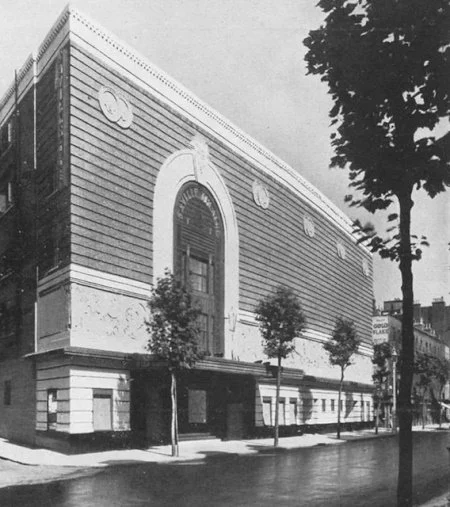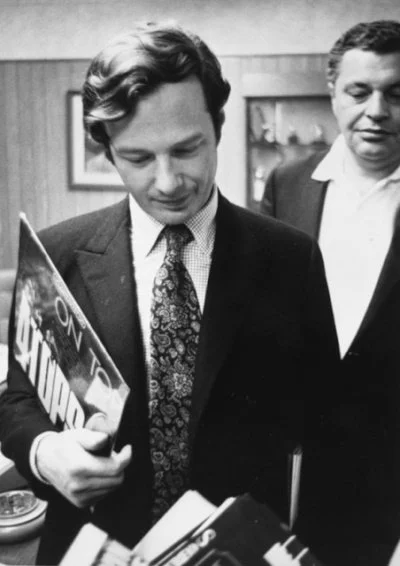The Life of Brian
EPSTEIN’S SAVILLE ADVENTURES, 4 TOPS INCLUDED
“The Beatles, and John in particular, loved [Smokey] Robinson’s group, the Miracles, before they knew the name of the singer whose angelic voice on “Who’s Lovin’ You” cracked at just the right moments, turning an elegant pop song into a heady lament.”
“R&B rhythms were beguiling and sinuous, the chords cleverly structured, the lyrics literate and urbane: this was singing and playing beyond the reach of the Beatles, for now, but they began incorporating Motown songs into their act, while John sought to emulate the emotional intelligence he heard in Smokey’s voice.”
Above are brief extracts from an engaging, insightful new book about “the volatile, madly creative chemistry” between John Lennon and Paul McCartney. Its title is John & Paul: A Love Story in Songs, its author is Ian Leslie.
The Four Tops with Brian Epstein in London (photo: Alamy)
The Beatles’ role in Motown history is well-known and well-documented: how the group acknowledged and credited the influence of Hitsville’s artists and music; how the inclusion of three Jobete copyrights on their second album (even when royalty-discounted in the U.S.) blessed Motown with substantial income and helped it to grow; and how Sgt. Pepper’s Lonely Heart Club Band captivated Motown songwriters and producers, including Holland/Dozier/Holland, inspiring them to become ever more creative.
Less familiar is that it was the Beatles’ manager, Brian Epstein, who helped to take Motown – and the Four Tops, in particular – to new heights of popularity in Britain when he bought a London theatre and booked a series of concerts there in 1966-67 which were about as hip as anything in culture and showbiz at the time.
“I believe there is a big market for pop music and light entertainment in the West End,” the entrepreneur told London newspaper the Evening Standard in November ’66. “Mr. Epstein…is bringing the Four Tops, an American group of coloured singers, to the Saville next week.”
Indeed, he did. The quartet played two sell-out shows on November 13 – their first concert performances in the U.K. – as “Reach Out I’ll Be There” ruled the country’s charts for a third consecutive week. Tickets for the first show sold out within days of going on sale, and the Saville audience that night was crowded with some of the biggest names in music, including (by Billboard’s account) John Lennon, Mick Jagger, Georgie Fame, Eric Burdon and Sir Joseph Lockwood, chief executive of Motown’s international licensee, EMI Records. The venue’s stage backcloth was reportedly made from a drawing by Paul McCartney, and this was its first use.
Epstein had booked the Tops during a visit to the U.S. in October 1966. One part of the deal covered a week’s worth of U.K. promotional activities by the group, including the Saville show and an appearance on TV’s highly-rated Ready Steady Go! His NEMS Enterprises paid Motown’s talent management arm, ITMI, a total of $10,000 (equivalent to $99,000 today) for “the services of the artists.” It also agreed to pay for luxury hotel accommodation and local transportation for nine people, including the performers. “The artists shall receive One Hundred (100%) Percent solo star billing,” added the contract.
The Saville Theatre on London’s Shaftesbury Avenue
NEMS incurred a substantial loss under these terms, even with the Saville sell-out shows, but they enhanced Epstein’s reputation. “The point is that Brian went into the deal knowing a loss would result,” says Beatles historian Mark Lewisohn, “such was his passion, his commitment, to honouring this great music. It was typical of the man and the way he worked. Who else would have done it?”
“Four Tops spin B.O. Magic in U.K. dates,” reported Billboard days later, adding, “The fantastic reception the Tops were accorded should assure Epstein of boom box-office takings when the group undertakes a nationwide tour of Britain for him in January.”
The October deal’s other part covered that tour (with Brenda Holloway originally earmarked as opening act). This time, in addition to the artists’ performance fees, NEMS agreed to pay airfares for nine people to and from the U.S., five of which would be first-class. The itinerary took in nine cities, opening in London on January 28, wrapping up in Leicester on February 5. “Brian was a young man, just a little older than we were,” reminisced the Tops’ Duke Fakir in his 2022 autobiography, I’ll Be There, “a nice Jewish guy who was easy to talk to, free-spirited but also a savvy businessman, an expert in marketing.”
The Saville after-party at Epstein’s London townhouse added to the sense of triumph. Reportedly among the guests were John Lennon, Mick Jagger, George Harrison and Keith Richards. “It was a party to behold,” wrote Fakir. “All of the artists were very nice and open, and it felt a lot like any artistic community in America where musicians gravitate to each other and shake hands and talk music.”
Two months later, the Four Tops’ cross-country trek scaled up their popularity, beginning with two sell-outs at London’s 7,000-seat Royal Albert Hall, followed by shows in Liverpool, Newcastle, Glasgow, Manchester and Birmingham, among other cities (Brenda Holloway did not join them, as it turned out). Disc jockey Tony Hall, who was recruited as MC for both the Saville dates and the ’67 tour, told me, “They were fantastic concerts. I also remember…that at one of those concerts, possibly the first one, I was the first guy to get audiences up on their feet to actually join in. I think that’s the first time any British audience ever got to its feet.”
The news even crossed the Atlantic. “The Motown group was met in London by banner headlines,” reported the Detroit Free Press, “two sellout audiences of 14,000 screaming, cheering fans and a cordon of 75 London bobbies to help keep the peace.” The paper’s “teen writer,” Loraine Alterman, quoted lead singer Levi Stubbs: “After every performance in England, we had to run straight into a limousine since the fans were so enthusiastic. They don’t try to tear your clothes off like kids here.”
Brian Epstein visits Motown in Detroit
The Beatles connection continued. “We were at John Lennon’s house a couple of times, too,” the Tops’ Lawrence Payton told Alterman. “John’s house is like you would think it would be. Fantastic sounds systems all over the place.”
That Epstein’s commitment to the Tops had elevated Motown’s overall profile in the U.K. soon became apparent. Three of their albums reached the Top 10 – Four Tops Live! spent a total of 72 weeks on the charts – and in February 1968, their Greatest Hits package became the Detroit firm’s first-ever Number One album there.
In 1966, Tamla Motown (as the label was identified in Britain) had scored five Top 20 successes; in 1967, that number rose to 13, including first-time hits for Gladys Knight & the Pips and the Marvelettes. After Epstein announced that Traffic would perform at the Saville in October, there was speculation that Stevie Wonder would be another act soon booked. Meanwhile, Knight & the Pips played the theatre on December 3, “and beautifully outclassed the majority of previous Sunday shows,” wrote Record Mirror reviewer Lon Goddard.
By then, however, tragedy had struck: Brian Epstein died in London on August 27, 1967 of an accidental drug overdose. That week, Sgt. Pepper’s Lonely Hearts Club Band was at the summit of the American and British charts, while in the latter, Four Tops Live! was returning to the Top 20.
On the Billboard Hot 100, the Beatles’ “All You Need Is Love” had just been dislodged from Number One, while Diana Ross & the Supremes’ “Reflections” was rapidly scaling the Top 10. Years later, Lamont Dozier admitted that the sound of that Motown hit was inspired by the Beatles’ manipulation of studio equipment. “We created the unusual sounds on that recording by running a test oscillator through a bunch of effects,” he recalled, adding that he and fellow producer Brian Holland wanted to do something “more adventurous.” Just like Brian Epstein had sought to do with the Saville Theatre one year earlier, and recruited the Four Tops to help him do so.
You might even call it The Beatles & Motown: A Love Story in Songs.
Credit notes: assistance with this WGB edition was provided by Mark Lewisohn, author of a three-part, definitive biography of the Beatles, of which the first part, All These Years: Tune In, was published in 2013. Another invaluable resource was Ray Coleman’s 1989 book, Brian Epstein: The Man Who Made The Beatles.
PR notes: in January 1966, Motown publicist Al Abrams put out a press release which included a claim that the Beatles had asked Holland/Dozier/Holland to write a couple of songs for them. “We waited and waited,” recalled Eddie and Brian in their subsequent autobiography. “We were sure something would happen. It never did. In fact, we never heard another word about it, and we never got to the bottom of why it didn’t.”
Sunshine notes: the Saville Theatre was built in 1931, and its last production as a theatre took place in 1969. It then became a cinema, for more than 50 years. Currently, the venue is being redeveloped into the first permanent European home for Cirque du Soleil. Given that Cirque produced a tribute show to the Beatles which ran for 18 years in Las Vegas, Eppy would have been pleased.


